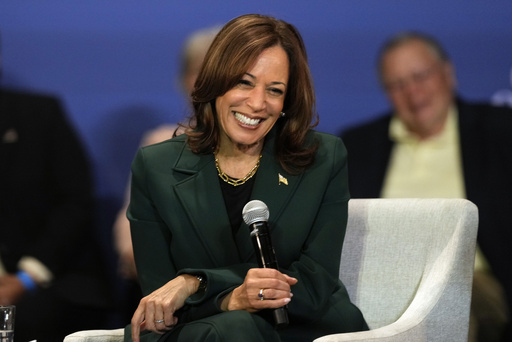
Millions of Americans struggle to afford homeownership or suitable rental options, making housing a critical concern as the presidential election approaches.
The primary factor contributing to this issue is the significant lack of available homes for sale, which causes an imbalance between buyers and sellers.
Economists estimate that the deficit ranges from 1 million to 4 million homes, and for nearly a decade, this shortage has led to bidding wars that have driven the median sales price of existing U.S. homes up to a record high of $426,900 in June, despite a notable decline in home sales over the past two years.
Additionally, rising mortgage rates have further sidelined potential homebuyers. The average rate for a 30-year mortgage reached a peak of almost 8% late last year and currently sits at 6.44%.
Renters face challenges as well; although the median asking rent has started to stabilize after a surge in new apartment developments, it remains approximately 20% higher than pre-pandemic levels.
In light of this complicated housing landscape, both Vice President Kamala Harris and former President Donald Trump have proposed initiatives they believe will make homeownership more attainable for Americans.
Harris has unveiled a comprehensive plan designed to improve access to affordable housing for both buyers and renters, which includes offering first-time homebuyers up to $25,000 in down-payment assistance, tax breaks for builders, and federal funding to expedite construction in cities. She asserts that her plan aims to create 3 million new housing units over the next four years.
On the other hand, Trump has suggested tax incentives for homebuyers, the elimination of what he refers to as unnecessary regulations affecting home construction, and the reassignment of some federal land for residential projects. However, his campaign has not detailed these proposals. Trump also claims that his approach will lower housing expenses by addressing inflation and curbing illegal immigration.
While both candidates offer potentially beneficial ideas, experts warn that the effectiveness of their proposals largely depends on gaining sufficient support from Congress, which may not be guaranteed for the next administration. Economists recognize that the candidates’ platforms highlight some promising strategies but do not provide definitive solutions to the longstanding difficulties in the housing market.
Examining their essential proposals reveals key insights. Trump argues that the immigration crisis exacerbates the nation’s housing challenges, contending that mass deportations could reduce housing demand and enhance affordability.
Nevertheless, experts, including Harvard’s Chris Herbert, assert that rising costs result from increasing interest rates and a pandemic-induced surge in housing demand, not from immigration levels.
Jim Tobin, CEO of the National Association of Home Builders, expressed concern that mass deportations could further exacerbate labor shortages in the homebuilding sector, as many workers are foreign-born.
Sarah Saadian of the National Low Income Housing Coalition added that undocumented immigrants often live in overcrowded conditions, indicating that evicting them would not necessarily result in vacant units, nor would it solve the affordability crisis.
Harris directly intends to aid homebuyers through her proposed down payment assistance program, which would provide up to $25,000 to first-time buyers who have demonstrated reliable rent payment for two years.
She emphasizes that this financial support isn’t unprecedented; data shows that nearly 75% of single-family mortgages included similar assistance as of 2019.
However, some economists warn that such buyer incentives could drive prices even higher as long as the inventory of available homes remains limited, potentially undermining the goal of making homeownership feasible.
The situation may vary by market – for example, $25,000 may significantly bolster efforts in Detroit yet fall short in Los Angeles.
Historically, the federal government has offered tax incentives for homebuyers, such as the first-time homebuyer tax credit initiated by the Obama administration in 2008 during the housing market crisis. Although this measure initially spurred sales, the housing market continued to struggle until 2012.
Trump’s campaign promises to support first-time buyers, though details are scant. He mentions plans to reduce mortgage rates by combatting inflation, but experts warn that his proposed agenda could worsen inflation, despite its recent decline to a three-year low.
Both candidates converge on the necessity to reform zoning laws and utilize federal lands to increase housing availability. Trump’s promises include tackling zoning regulations to promote faster housing production, but specifics are lacking.
Harris’ plan entails a $40 billion fund aimed at incentivizing local governments to relax zoning regulations, although they must demonstrate a commitment to affordable housing development.
Additionally, both candidates indicate some willingness to make portions of federal land available for housing projects, albeit without thorough explanations.
To illustrate these proposals, Harris references an initiative by the Biden administration in Las Vegas, which involved the Bureau of Land Management selling 20 acres of land at a discount for building affordable homes targeting families with a household income of up to $70,000 annually.
However, experts like Nicholas Irwin from the University of Nevada Las Vegas caution that this singular project will hardly address the significant housing shortage, particularly in Southern Nevada, which faces a deficit of roughly 75,000 housing units.
In summary, while both candidates’ plans present various strategies aimed at addressing the housing crisis, experts remain skeptical about their potential efficacy in meeting immediate needs.
